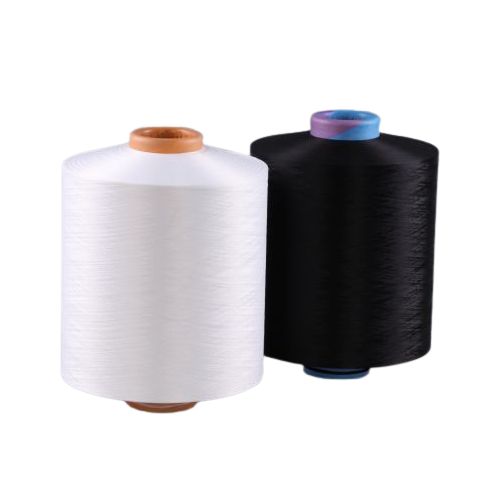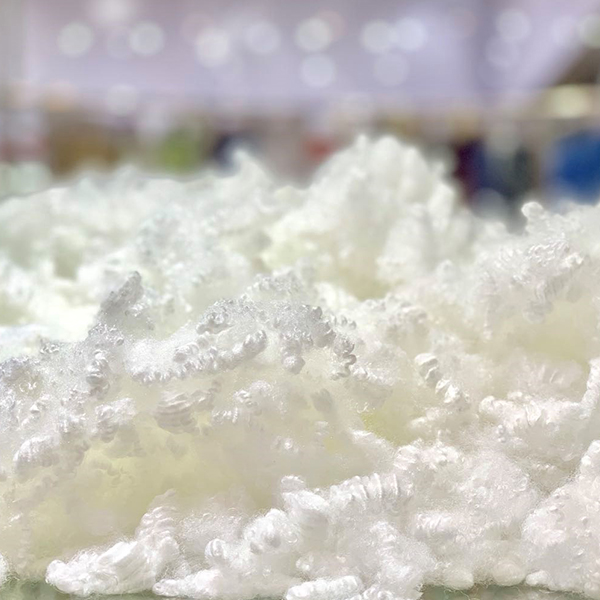A popular synthetic material, polyester is valued for its affordability, strength, and adaptability. Found in clothing, upholstery, and industrial products, it mainly exists in two forms: polyester staple fibers (PSF) and polyester filament fibers (PF/PFY). Though both come from the same PET material, they differ in structure, production, and applications. This article highlights their key differences.
Structure and Physical Form

Polyester Filament:
Polyester filament fibers are long continuous strands of polyester. These fibers can either be mono-filament (a single continuous strand) or multi-filament (a bundle of several continuous strands twisted together).
The most defining characteristic of filament fibers is their length and smoothness. Since they are continuous, they can extend over long distances without breaks or joints, resulting in smooth, lustrous fabrics.
Polyester Staple:
In contrast, polyester staple fibers are short fibers. They are cut to a specific length, typically ranging from 1 to 15 centimeters, to mimic natural fibers like cotton or wool.
Typically, traditional spinning techniques are used to crimp and spin staple fibers into yarns. The result is a fuzzier, softer, and more textured yarn or fabric that has more bulk than filament-based products.
Manufacturing Process
Polyester Filament:
The process begins with melt spinning. Continuous filaments are created by melting PET chips and extruding them through spinnerets. These filaments are then cooled, drawn, and wound onto cones or bobbins. Various filament types can be produced by fine-tuning the production process, including:
- POY (Partially Oriented Yarn): Requires further drawing before use.
- FDY (Fully Drawn Yarn): Ready for direct use in weaving or knitting.
- DTY (Draw Textured Yarn): Crimped or textured to simulate the feel of natural fibers.

Polyester Staple:
The staple fiber manufacturing process is a bit more complex. It also begins with melting PET chips and extruding them through spinnerets. However, after cooling, the continuous filaments are collected into tow (a rope-like bundle), which is then drawn, crimped, and cut into staple lengths.
These fibers may be used as:
- Virgin Polyester Staple Fiber (vPSF): Made from pure PET chips.
- Recycled polyester staple fiber (rPSF) is derived from textile waste or post-consumer PET bottles.
Texture and Appearance
Filament Fibers:
Filament yarns typically produce smooth, silky, and lustrous fabrics. They have a clean, uniform appearance and feel, making them ideal for high-sheen and elegant fabrics like satin or taffeta. The smoothness also allows for high strength and low pilling, contributing to durability.
Staple Fibers:
Staple yarns tend to have a more matte or natural appearance. They provide a softer, warmer, and fuzzier texture, which is more akin to cotton or wool. However, fabrics made from staple fibers are more prone to pilling, especially with frequent wear or friction.
Spinning and Yarn Formation
Staple Fiber Yarn:
Staple fibers must be spun into yarn before they can be woven or knitted. This involves aligning the fibers and twisting them together. Depending on the desired properties, spinning can be done using ring spinning, open-end spinning, or air-jet spinning methods.
Because of the cut and crimped structure, staple fiber yarns tend to trap more air, offering better insulation and breathability.
Filament Yarn:
Filament fibers do not need to be spun in the traditional sense. They can be twisted into yarn directly after extrusion or used in flat, untextured form. This results in tighter, smoother, and stronger yarns. Filament yarns are used for both fine textiles and industrial applications.
Durability and Strength
Filament:
Due to their continuous structure, filament fibers have higher tensile strength than staple fibers. They also exhibit better abrasion resistance and are less likely to fray, which makes them suitable for high-stress applications such as seat belts, tire cords, or tents.
Staple:
Staple fibers have lower overall strength, especially if the yarn is loosely spun. The presence of fiber ends on the yarn surface contributes to higher friction and abrasion, which can lead to faster wear. However, the fuzziness can improve comfort and warmth, especially in apparel.
Moisture and Breathability
Staple Fiber:
Because of their bulkier and more porous structure, staple fiber fabrics tend to be more breathable and absorbent, making them more comfortable to wear in everyday garments like T-shirts, undergarments, or casual wear.
Filament Fiber:
Filament fibers are less absorbent and less breathable due to their smooth and compact structure. They may trap heat more easily, making them less comfortable in hot or humid environments. However, they dry quickly and resist moisture buildup, which can be beneficial in sportswear or swimwear.
Applications
Polyester Filament Applications:
- Textile Industry: Lingerie, activewear, linings, sarees, dresses
- Home Textiles: Curtains, upholstery fabrics
- Industrial Uses: Ropes, conveyor belts, seat belts
- Technical Textiles: Filter fabrics, geotextiles, tire cords
Polyester Staple Applications:
- Clothing: Casual wear, children’s clothing, sweaters, socks
- Home Textiles: Bed sheets, pillow filling, mattress padding
- Nonwovens: Wipes, insulation, filtration, automotive interiors
- Blending: Often blended with cotton, viscose, or wool for better texture
Cost and Market Considerations
Filament Fiber:
Filament fibers are generally more cost-effective in applications where strength, appearance, and uniformity are critical. Their production cost may be lower per unit due to fewer processing steps (no need for spinning) and higher efficiency in weaving/knitting.
Staple Fiber:
Although staple fibers require additional processing (cutting, spinning), they remain cost-competitive, especially in blended applications and nonwovens. Recycled PSF is widely used in the global textile and filling industries as a low-cost alternative to virgin materials.
Environmental Impact
Both polyester filament and staple are synthetic and non-biodegradable, which raises environmental concerns. However, advances in recycled polyester—particularly recycled polyester staple fiber (rPSF) from PET bottles—have helped reduce the environmental footprint.
- Recycled PSF is a key material in the circular economy, especially in insulation, fillings, and nonwoven products.
- Recycled filament yarns are gaining popularity in eco-fashion and sustainable sportswear, though the recycling process is more complex.
| Feature | Polyester Filament | Polyester Staple |
| Length | Continuous | Short, cut fibers |
| Texture | Smooth, lustrous | Fuzzy, soft |
| Strength | Higher tensile strength | Lower strength |
| Appearance | Glossy, sleek | Matte, cotton-like |
| Production | Melt-spun directly into yarn | Melt-spun, drawn, cut into staple |
| Uses | Fashion, industrial, technical | Apparel, home textiles, nonwovens |
| Breathability | Lower | Higher |
| Cost | Cost-effective per unit | May have a higher processing cost |
| Pilling | Low tendency | Higher tendency |
| Comfort | Less soft | More comfortable, warmer |
Conclusion
Polyester staples and filaments differ in length, texture, and use. The filament is smooth and strong; the staple is soft and cotton-like. Filament suits performance fabrics, while staple offers comfort. Both are available in recycled options for sustainability.

